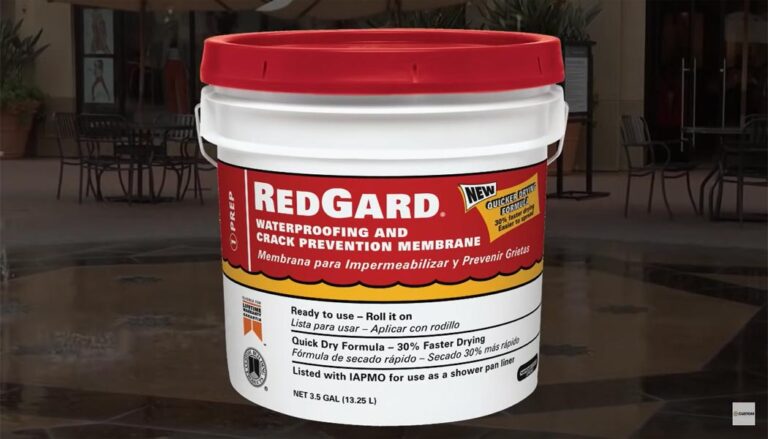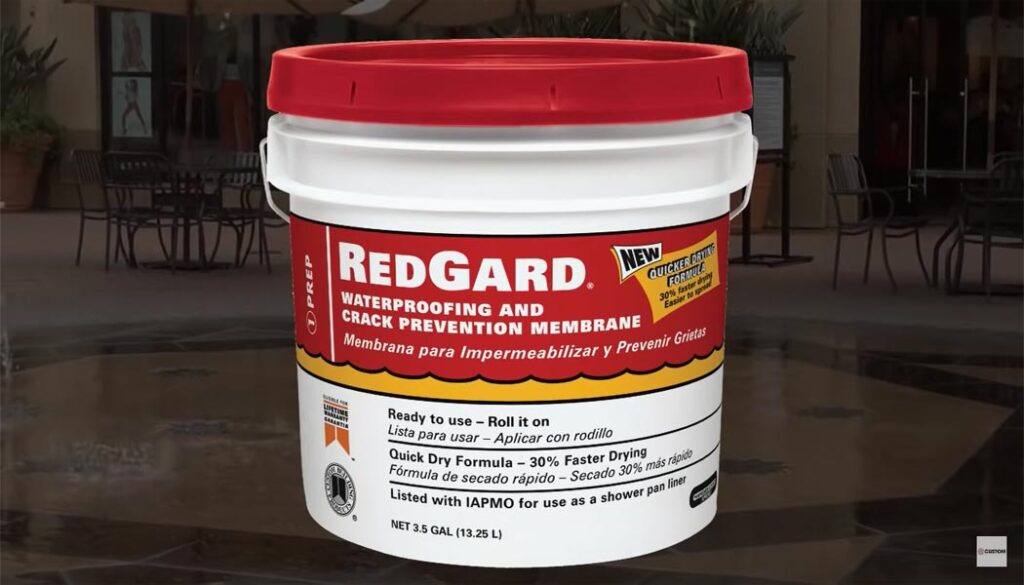
Can You Paint Over Redgard? [Find Out Here]
Yes, you can paint over Redgard!
If you’re wondering whether it’s possible to apply a fresh coat of paint on top of Redgard, the answer is a resounding yes. Note that Redgard is a popular waterproofing membrane used in construction and renovation projects.

Are you curious to discover more? So, let’s delve into the world of Redgard and uncover whether painting over it is a viable option.
What Is RedGard?
RedGard is a liquid-applied membrane that is widely used in construction and home improvement projects. Manufactured by Custom Building Products, it is specifically designed to provide waterproofing and crack prevention in areas prone to moisture, such as bathrooms and showers.
RedGard serves as a durable and seamless barrier, protecting surfaces like cement boards, gypsum boards, and plywood from water damage. Its primary purpose is to prevent water from seeping through and causing issues like rotting and mold growth.
Additionally, it has excellent crack isolation properties, meaning it can bridge and reinforce small cracks in the substrate, maintaining the surface’s integrity. It also enhances tile adhesion, creating a stable surface for tile installation. Easy to apply with a roller, brush, or trowel, RedGard dries quickly. It can be used in various moisture-prone areas, including laundry rooms, kitchens, and balconies.
Its versatility, effectiveness, and ease of use make RedGard a preferred choice for both professionals and DIY enthusiasts seeking reliable waterproofing and crack prevention solutions.
Can You Paint over Redgard?
Yes, You Can Paint Over Redgard.
While painting over Redgard is possible, it’s important to note that the painted surface may require additional maintenance compared to traditional painted surfaces. The waterproofing properties of Redgard can affect the breathability of the paint, potentially leading to moisture issues if not properly maintained. Regular inspection and upkeep, such as addressing any cracks or gaps that may develop over time, can help preserve the integrity of the painted surface.
Redgard enhances the aesthetics of the treated area. It typically has a bright red or pink color, which may not be desired in all situations. By painting over it, you can customize the appearance and create a cohesive look of the surface to match your preferred color scheme or decor.
It provides excellent waterproofing and crack prevention properties, but the addition of paint can further enhance the durability of the surface. Paint acts as an additional protective layer, guarding against wear, abrasion, and potential damage. It also makes the surface easier to clean and maintain, as painted surfaces are generally more resistant to dirt, grime, and stains.
Painting over Redgard gives you the freedom to personalize your space according to your preferences. Whether you want a vibrant and colorful shower area or a muted and sophisticated bathroom, painting over Redgard allows you to achieve the desired aesthetic.
Remember, proper surface preparation is crucial before painting over Redgard. Ensure the Redgard surface is clean, dry, and free from any contaminants or loose particles. Additionally, consult the specific instructions provided by the paint manufacturer and follow their guidelines for application over Redgard.
How to Paint over Redgard Surface?
Painting over a Redgard surface requires careful preparation and the use of appropriate materials. Redgard is a waterproofing membrane typically used in areas such as showers, bathrooms, and other wet environments. To paint over a Redgard surface, follow these step-by-step instructions:
Gather the necessary materials:
- High-quality paint suitable for the desired surface (latex or oil-based, depending on the project)
- Paint roller and paint tray
- Paintbrushes (various sizes)
- Painter’s tape
- Drop cloths or plastic sheets
- Sandpaper (medium grit)
- Tack cloth or a damp cloth
- Primer (if necessary, based on the paint and surface condition)
Prepare the work area:
- Clear the area of any furniture or objects that may obstruct your painting process.
- Lay down drop cloths or plastic sheets to protect the surrounding surfaces from paint splatters or drips.
- Use painter’s tape to cover any fixtures, edges, or areas you want to keep free of paint.
Clean the Redgard surface:
- Remove any dust, dirt, or debris from the Redgard surface using a damp cloth or sponge.
- Allow the surface to dry completely before proceeding.
- Evaluate the Redgard surface:
- Check the condition of the Redgard surface for any cracks, peeling, or damage.
- If there are any issues, repair them before painting. Follow the manufacturer’s instructions for patching or repairing the Redgard surface.
Sand the Redgard surface:
- Lightly sand the Redgard surface with medium-grit sandpaper. This step helps create a rough texture for better paint adhesion.
- Be careful not to sand too aggressively, as it may damage the Redgard surface.
Clean the sanded surface:
- Use a tack cloth or a damp cloth to remove any sanding dust or residue from the Redgard surface.
- Ensure the surface is completely clean and dry before moving forward.
Apply a primer (if necessary):
- Check the paint you’ve chosen and follow its recommendations regarding the need for a primer.
- If a primer is required or recommended, apply it to the Redgard surface according to the manufacturer’s instructions.
- Allow the primer to dry completely before proceeding.
Paint the Redgard surface:
- Stir the paint thoroughly to ensure an even consistency.
- Start by using a paintbrush to cut in around the edges and corners of the Redgard surface.
- Then, use a paint roller to apply the paint to the larger areas of the Redgard surface.
- Work in small sections, maintaining a wet edge to prevent visible brush or roller marks.
- Apply multiple coats as needed, allowing each coat to dry completely before applying the next one.
- Follow the paint manufacturer’s instructions regarding drying times and reapplication.
Remove painter’s tape:
- Carefully remove the painter’s tape before the paint is fully dry to prevent it from peeling off with the tape.
- Slowly peel the tape away at a 45-degree angle, pulling it back onto itself.
Clean up and allow the paint to cure:
- Clean your brushes, roller, and paint tray according to the instructions provided by the paint manufacturer.
- Allow the paint to cure fully based on the paint manufacturer’s recommendations before subjecting it to moisture or heavy use.
- By following these steps, you should be able to successfully paint over a Redgard surface, providing a fresh and updated look while maintaining the waterproofing qualities of the Redgard membrane.
What Is Redgard Designed to Do?
Redgard is a specialized product designed for specific purposes in the construction and renovation industry. Here are the key points outlining what Redgard is designed to do:
- Redgard is a waterproofing and crack prevention membrane.
- It forms a barrier against water infiltration in tile and stone installations.
- Redgard helps prevent cracks caused by substrate movement or temperature changes.
- It offers moisture protection in areas prone to water exposure.
- Redgard resists the growth of mold and mildew.
- It can be easily applied by rolling, brushing, or troweling.
- Redgard is versatile and compatible with various substrates, including concrete and plywood.
- It promotes a healthier environment by preventing moisture-related damage.
- Redgard meets industry standards and building codes for waterproofing.
- It provides a durable and long-lasting solution for tile and stone installations.
What Type of Paint Can You Use over Redgard?
Redgard, a waterproofing membrane, can indeed be painted over with acrylic paint.
Acrylic paint is commonly recommended for this purpose due to its compatibility with Redgard and its ability to adhere well to the surface.
Acrylic paint is a water-based paint that dries quickly and forms a durable, flexible film. It offers good adhesion to various surfaces, including Redgard, and is suitable for both interior and exterior applications. When using acrylic paint over Redgard, it is recommended to choose a high-quality acrylic paint specifically designed for high-moisture areas or bathrooms.
Before applying acrylic paint, ensure that the Redgard surface is clean, dry, and free from any contaminants. It may be necessary to lightly sand the Redgard surface to promote adhesion. Applying a primer specifically formulated for acrylic paints can also enhance the paint’s adhesion and durability.
As always, it is advisable to follow the manufacturer’s instructions on the Redgard and acrylic paint products for the best results. If there are any specific recommendations provided by the manufacturer, they should be followed to ensure proper adhesion and longevity of the painted surface.
Does Paint Stick Well to Redgard?
Certainly! Paint generally adheres well to Redgard. Redgard is a waterproofing membrane that creates a smooth and stable surface.
It is important to ensure the Redgard surface is clean, dry, and free from any contaminants before applying paint. This will help promote good adhesion and ensure a durable and long-lasting paint finish.
Following the manufacturer’s guidelines and using compatible paint products will further enhance the adhesion.
Does Redgard Need Primer?
It is recommended to use a primer before applying Redgard.
Priming the substrate helps improve adhesion and promotes better performance of Redgard. A suitable primer for Redgard application is a high-quality latex-based primer such as KILZ Premium, Zinsser Bulls Eye 1-2-3, or Sherwin-Williams Multi-Purpose Latex Primer.
Always refer to the manufacturer’s instructions and consult with a professional for specific project requirements.
Can You Sand Redgard before Painting?
Yes, you can sand Redgard before painting.
Sanding Redgard helps create a smoother surface for better paint adhesion. It removes any imperfections, such as bumps or unevenness, and provides a more even and uniform substrate. Sanding also helps to roughen up the Redgard surface, allowing the paint to bond more effectively. It is important to follow proper safety precautions while sanding, such as wearing a mask and goggles to protect yourself from dust.
Final Thoughts
The question of whether you can paint over Redgard has been thoroughly examined, taking into account various factors and considerations. After careful analysis, the final verdict is that painting over Redgard is indeed possible, but it requires proper preparation and adherence to certain guidelines.
Choosing the right type of paint is crucial. Acrylic latex paints, specifically those formulated for high-adhesion or masonry surfaces, are often recommended for painting over Redgard. These paints have properties that enable them to adhere well to challenging surfaces like Redgard and provide a durable finish.
